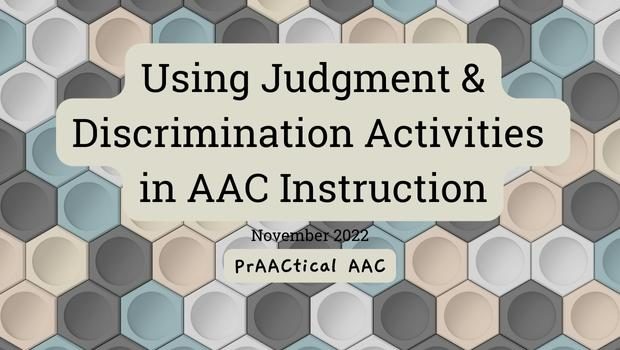Using Judgment & Discrimination Activities in AAC Instruction

There are many paths to successful AAC use.
For some people, access to language-rich AAC tools and communication partners who model AAC, use naturalistic methods of eliciting language, offer adequate wait time, and respond to communicative attempts in supportive ways, is sufficient.
Many individuals, however, need additional support to develop robust language and AAC skills. For them, explicit AAC instruction can be very beneficial. In a previous post, we shared thoughts on strengthening our AAC services with the use of thoughtful instructional sequences.
Discrimination learning can play a helpful role in sequencing our instructional activities. Learning to discriminate between one thing and another is a part of typical language development. Babies learn to discriminate between phonemes (e.g., /ma/ vs /ba/), for example. It also helps them to determine that ‘dog’ applies to some 4-legged, furry critters and not to others. As children mature, they learn a variety of linguistic concepts using discrimination (e.g., heavy/light, fair/unjust) which builds a foundation for categorization skills.
Judgment and discrimination activities are used frequently in some areas of speech-language pathology. For example, we engage students with hearing difficulties in activities that require them to discriminate between two words or sounds that vary on one or more dimensions (e.g., ‘Which one goes with drink: cut, cup?’ “Which is louder, A or B?’ ‘Which is the doorbell, this one or that one?’). In emergency literacy, discrimination tasks are sometimes used for things like judging pairs of rhyming words and differentiating between long and short words.
In improving articulation skills, we sometimes use auditory discrimination tasks, too.
- ‘Does this start (or end) with ___ (the target sound)?’
- ‘Is this a nose sound or a mouth sound?’
- ‘Which word uses the angry kitten sound: pop or cake?”
Tasks that require learners to discriminate between things or make a judgment on things are often part of a thoughtful sequence of AAC teaching activities. They can be used to build skills or their components, and are most effective when there is some conversation or dialogue about each response. This allows us to talk about WHY a particular answer makes sense (or doesn’t).
These are especially useful when working on vocabulary/semantics, morphology, syntax, and narrative language. AAC learners often enjoy these activities because they are easy and engaging.
The responses are binary, requiring the learner to indicate responses like yes/no, belongs/does not belong, true/false, agree/disagree, and thumbs up/down. Because these are relatively quick to produce and don’t require a great deal of physical effort, these are especially helpful when working with individuals who have significant motor limitations.
Judgment and discrimination activities can be used in several areas of AAC instruction. In a future post, we’ll discuss some examples across different domains of language. In the meantime, if you use these in your AAC teaching, we’d love to hear from you. Reach out through the contact form or by leaving a comment below.
Filed under: Featured Posts, PrAACtical Thinking
This post was written by Carole Zangari
